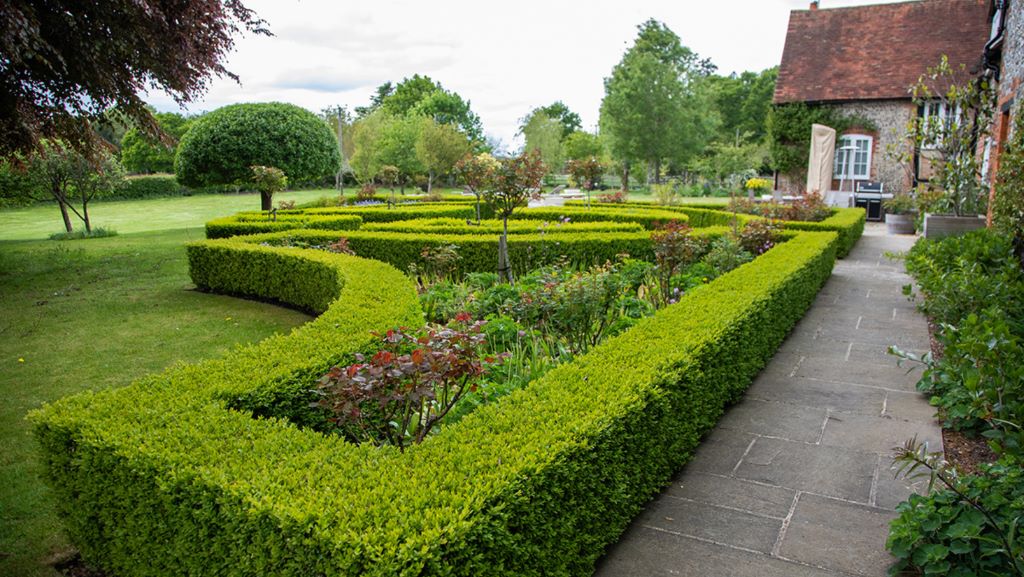A lush, full cedar hedge can be the perfect living fence or barrier to provide privacy and beauty for your landscape. Cedar hedges not only look elegant with their conical shapes and rich green foliage, but they also give off a lovely aroma and are low maintenance once established.
Making a cedar hedge does require some time and effort on the front end. But caring for a mature hedge is easy, making cedars one of the best choices for hedging plants. Follow this step-by-step guide to learn everything you need to know about choosing, planting, and caring for cedar hedges so yours can thrive for years to come.
Choosing the Right Cedar for Hedging
The first decision you’ll need to make is choosing which type of cedar is best for your hedge. Here are some top species to consider:
Eastern Red Cedar
This fast-growing native cedar has dense, bright green needles and tan bark when mature. It tolerates heat, drought, and clay soil fairly well. Eastern red cedar can reach 50 feet tall and 20 feet wide at maturity. Zones 2-9.
Western Red Cedar
With lacy blue-green foliage, peeling cinnamon bark, and pyramidal form, this cedar is ideal for privacy hedges. It’s also highly deer-resistant. Western red cedar will reach 60 feet tall and 25 feet wide at maturity. Zones 3-7.
Deodar Cedar
One of the most popular hedge choices, deodar cedar is prized for its weeping tips and silver-blue needles. It has a tighter, neater appearance than other cedars when pruned. Deodar cedar will mature at 50 feet tall and 20 feet wide. Zones 6-9.
Emerald Green Thuja
For a fast-growing, bright green hedge, this arborvitae cultivar is a great choice. It tolerates pruning well and is easy to shape. Emerald green thuja will reach 12-15 feet tall and 3-5 feet wide at maturity. Zones 5-8.
I recommend choosing a type of cedar suited for your specific hardiness zone and climate. Consider the mature size as well to ensure it will fit your landscape.
Planning Your Hedge Layout
Once you’ve picked the perfect cedar for hedging, it’s time to plan out your design. Here are some key factors to consider:
Spacing
Cedar hedging plants should be spaced 2-3 feet apart if you want a fuller, tight hedge more quickly. Planting further apart (3-5 feet) will take longer to fill in but requires fewer plants.
Location
Pick a spot with well-draining soil and 6+ hours of full sun for best growth. Cedars need good airflow so don’t plant too close to structures.
Height and Width
Consider the cedar species’ mature size and allow enough room for growth over time. Frame the boundaries clearly with stakes and string first.
Purpose
Decide if you want a privacy screen, living fence, perimeter border, or decorative feature. This will help determine the length, dimensions, and placement.
Take the time to carefully plan out your cedar hedge on paper first before purchasing materials and digging. Getting the layout right from the start will ensure your hedge thrives!
Best Cedar Hedge Plants
Here are some options to consider:
Fast-growing privacy choices:
- Western Red Cedar (Thuja plicata): This conifer tolerates shade and poor soil, grows 2-3 feet per year, and offers year-round privacy with its dense foliage.
- Eastern White Cedar (Thuja occidentalis): Similar to Western Red Cedar but slightly slower-growing (1-2 feet per year). It prefers sunnier locations and is deer-resistant.
- Emerald Green Arborvitae (Thuja occidentalis ‘Smaragd’): This popular compact cultivar grows 1-2 feet per year and excels in creating dense, formal hedges.
Slower-growing, elegant options:
- Degroot’s Spire Cedar (Chamaecyparis pisifera ‘Squarrosa’): This narrow, columnar conifer reaches 20 feet tall and tolerates various soils. It has a slower growth rate (6-12 inches per year) but offers unique texture and year-round interest.
- False Cypress (Chamaecyparis nootkatensis): This pyramidal tree grows 1-2 feet per year and boasts beautiful blue-green foliage. It prefers slightly acidic soil and thrives in cooler climates.
- Leyland Cypress (Cupressocyparis leylandii): This fast-growing evergreen (3-5 feet per year) reaches impressive heights but requires significant pruning and can be invasive in some regions.
Preparing the Planting Area
Now it’s time to get your hands dirty! Here are some key tips for prepping your planting area:
Remove Grass and Weeds
Eliminate all competing vegetation in the bed where you’ll plant the hedge. Dig or use a weed barrier fabric to clear a space.
Test Soil Drainage
Cedars need well-draining soil. Dig a hole 12” deep and fill with water. If it doesn’t drain in 24 hours, amend the soil with compost.
Add Compost or Peat Moss
Mix in 2-3 inches of organic material like compost or peat moss to improve moisture retention and nutrients.
Edge the Bed
Use a trenching shovel to dig a V-shaped trench around the perimeter to clearly define the planting bed.
Install Irrigation
Having an irrigation system in place will make watering hedges much easier long term. Plan this before planting.
Taking time to improve the soil and define the bed will go a long way in giving your cedar hedge the healthy start it needs.
Choosing and Planting Cedar Hedging
Now for the fun part—picking out your cedar plants! Here’s how to select quality specimens:
Purchase from Nursery
Buy 1-2 year old containerized plants from a reputable local nursery. These are easier to plant than bare root.
Look for Healthy Foliage
Choose plants with vibrant, green needles and no yellowing or browning. Avoid thin, scraggly plants.
Check Roots
Make sure the root system is not root bound and has plenty of healthy fine roots.
Time It Right
Plant cedars in early spring after the last frost or fall at least 6 weeks before first frost.
Space the plants evenly along your prepared hedge bed following your planned design. Here are some tips for proper planting:
- Dig holes the depth of the root ball and 2-3 times as wide.
- Carefully place each plant in its hole, keeping the top of the root ball even with the ground.
- Backfill with native soil, tamping down gently to remove air pockets.
- Water thoroughly until the soil is moistened at least 12” deep.
- Add a 2-3” layer of mulch around each plant, keeping it 3” away from stems.
Proper planting gives your cedar hedge the best start during this critical establishment period. Be sure not to rush this important step.
Caring for Cedar Hedges Long Term
Caring for your established cedar hedge mainly involves occasional pruning, watering, and pest monitoring. Here are some key care tips:
Annual Pruning
Trim back new growth in spring or fall to shape as needed. Never remove more than 1/3 of the plant.
Watering
Water deeply 2-3 times per month during dry periods for the first two years. Mature cedars are quite drought tolerant.
Weed Control
Apply 2-3” of fresh cedar mulch around the hedge every spring. This will help suppress weeds.
Pest Management
Watch for signs of disease like blight or damaging insects. Apply appropriate organic treatments promptly.
Fertilizing
Apply a slow release, low nitrogen fertilizer annually in early spring to boost growth if needed.
With just a little routine pruning and care, a mature cedar hedge is easy to maintain and can last decades in the landscape.
Troubleshooting Common Cedar Hedging Problems
Even with the best care, hedges can sometimes struggle with certain issues. Here are some common cedar hedging problems and how to fix them:
Sparse Growth
If the hedge is thin or has bare spots, the plants may be spaced too far apart. Try filling in gaps with new cedar plants.
Getting Leggy
Leggy growth happens when interior foliage lacks sun. Prune vigorously to stimulate dense growth inside the hedge.
Drainage Issues
Standing water or overly moist soil can cause root rot. Improve drainage by installing a French drain system.
Insect Damage
Spider mites, bagworms, and other insects can harm cedars. Apply insecticidal soap or neem oil as needed.
Disease
Prevent fungal disease like blight by spacing plants properly, avoiding overhead watering, and using preventive fungicides.
Address any hedge issues promptly to maintain an attractive, thriving privacy screen. Your efforts will pay off for years to come.
Frequently Asked Questions About Cedar Hedges
Here are answers to some common questions about growing and caring for cedar hedges:
How close together should I space cedar hedge plants?
For a fuller hedge faster, space small plants 2 feet apart. For slower fill-in, space 4 feet apart. The closer the spacing, the more plants you’ll need.
What is the best time to trim a cedar hedge?
Cedars can be trimmed anytime, but pruning in early spring or late fall causes less stress on the plants. Never prune more than 1/3 of the plant.
How do I fertilize a cedar hedge?
Apply a low nitrogen, slow release fertilizer annually in early spring. Scatter per label instructions around the base of each plant, not directly on stems.
How much sun does a cedar hedge need?
Cedars need at least 6 hours of direct sun daily. Morning sun is preferable to hot afternoon sun. Too much shade will cause sparse, open growth.
How do I revive a dying cedar hedge?
For a thinning, dying hedge, start by pruning out dead branches. Then fertilize lightly, mulch to retain moisture, and water deeply twice weekly during dry periods. This can often rejuvenate old cedars.
Conclusion
Creating a beautifully manicured cedar hedge to enhance your landscape is very achievable with the right planning and care. Follow this guide when selecting, planting, and maintaining your hedge, and you’ll be rewarded with an elegant feature that provides privacy and curb appeal for years to come. With their lush greenery, sweet scent, and stately presence, cedar hedges are a lovely addition to any home.
For the best gardening tips, especially on creating a thriving cedar hedge, focus on selecting the right cedar variety, properly spacing and situating the plants, preparing the soil effectively, ensuring adequate water supply until establishment, and maintaining with regular pruning, mulching, and pest control. It’s also crucial to address any drainage issues promptly and replenish sparse areas with new plants as necessary.
In no time, with a little patience and TLC, you can grow a stunning cedar hedge that perfectly frames your yard or provides a verdant living fence or border sure to impress. Your efforts will pay off for decades to come thanks to the natural longevity of hardy cedar hedging plants.

















